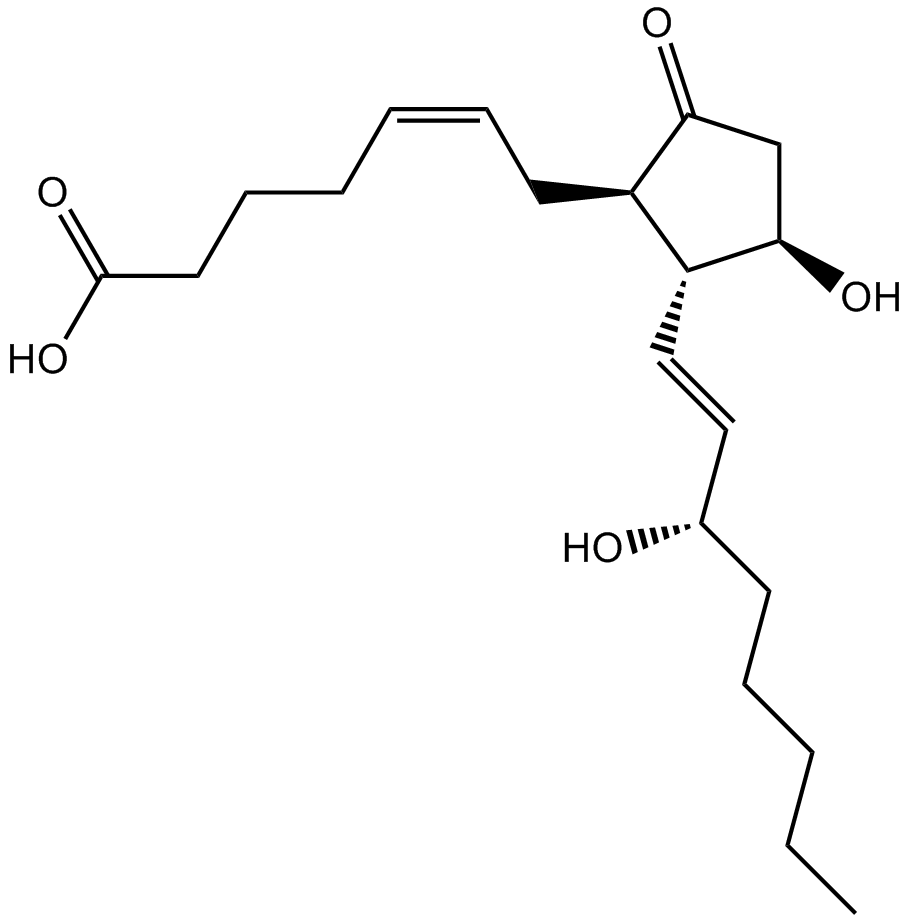Prostaglandin E2 (Synonyms: Dinoprostone, PGE2) |
| Catalog No.GC15948 |
Prostaglandin E2 is a major metabolite produced from arachidonic acid catalyzed by Cyclooxygenase (COX).
Products are for research use only. Not for human use. We do not sell to patients.

Cas No.: 363-24-6
Sample solution is provided at 25 µL, 10mM.
Prostaglandin E2 is a major metabolite produced from arachidonic acid catalyzed by Cyclooxygenase (COX).It is also one of the most biologically active and widely studied prostaglandins. As a hormone-like substance that participate in a wide range of body functions such as the contraction and relaxation of smooth muscle, the dilation and constriction of blood vessels, control of blood pressure, and modulation of inflammation. [4]
Mouse bone marrow derived naïve macrophages produce prostaglandin E2 endogenously, resulting in anti-inflammatory gene expression upon differentiation induced by macrophage colony stimulating factor (M-CSF)[1]. Prostaglandin E2 has a mediator role for multiple inflammatory responses. Prostaglandin E2 receptors EP1, EP2, EP3 and EP4, are involved in the regulation of prostaglandin E2-related processes, of which[5,6], EP2 and EP4 are closely associated with inflammatio. EP2 and EP4 are involved in cytokine expression in E. coli-infected bovine endometrial tissue[7]. The affinity of PGE2 to these receptors varies according to the subtype and tissue type of the receptor, and the affinity constant (Kd) of prostaglandin E2 is about 1-10 nM. Prostaglandin E2 caused maximum relaxation of endothelin-1 precontracted vessels (EC50: 1.8×10-8M) [9].Prostaglandin E2-mediated enhancement of SPA expression in S. aureus-infected bovine endometrial tissue is dependent on EP4 receptor[4].PROSTAGLANDIN E2 induced the expression of some genes associated with alternative—M(IL-4)—cell activation including Arg1, Il4ra, and Clec10a (CD301), prostaglandin E2 accentuated IL-4-induced expression of Arg1, IL4ra, Clec10a, CD36, and Mrc1 when both stimuli where used simultaneously (co-stimulation), although it suppressed the expression of Retnla and Pparg, prostaglandin E2 did not alter IL-4-induced phosphorylation of STAT6. Thus, prostaglandin E2 has marked STAT6-independent effects on M(IL-4) cell activation[3].
The effect of intra-aortic administration of prostaglandin E2 on renal blood flow was studied in the rat anaesthetized with pentobarbitone. Dose-response curves demonstrate that under the conditions used, PROSTAGLANDIN E2 produced a biphasic change in renal vascular resistance, vasodilatation started at 0.01 μg/min and was maximal at about 3 μg/min, while at the highest dose used (20μg/min) prostaglandin E2 induced renal vasoconstriction[2].In addition, prostaglandin E2 have been shown to have complex effects on skeletal tissues, but a major effect in vivo is to increase both bone formation and bone resorption or bone remodeling, In a study in rats continuous infusion of prostaglandin E2 produced net bone loss while daily injection led to net bone gain[8].
References:
[1]: Na YR, Jung D, et,al. Endogenous prostaglandin E2 potentiates anti-inflammatory phenotype of macrophage through the CREB-C/EBP-β cascade. Eur J Immunol. 2015 Sep;45(9):2661-71. doi: 10.1002/eji.201545471. Epub 2015 Jul 20. PMID: 26118414.
[2]: Haylor J, Towers J. Renal vasodilator activity of prostaglandin E2 in the rat anaesthetized with pentobarbitone. Br J Pharmacol. 1982 May;76(1):131-7. doi: 10.1111/j.1476-5381.1982.tb09198.x. PMID: 6952954; PMCID: PMC2068751.
[3]: Sanin DE, Matsushita M, et,al. Mitochondrial Membrane Potential Regulates Nuclear Gene Expression in Macrophages Exposed to Prostaglandin E2. Immunity. 2018 Dec 18;49(6):1021-1033.e6. doi: 10.1016/j.immuni.2018.10.011. PMID: 30566880; PMCID: PMC7271981.
[4]: Liu K, Mao W, et,al. Prostaglandin E2 promotes Staphylococcus aureus infection via EP4 receptor in bovine endometrium. Microb Pathog. 2021 Sep;158:105019. doi: 10.1016/j.micpath.2021.105019. Epub 2021 Jun 6. PMID: 34107344.
[5]: Wu J, Liu B, et,al. Prostaglandin E2 Regulates Activation of Mouse Peritoneal Macrophages by Staphylococcus aureus through Toll-Like Receptor 2, Toll-Like Receptor 4, and NLRP3 Inflammasome Signaling. J Innate Immun. 2020;12(2):154-169. doi: 10.1159/000499604. Epub 2019 May 29. PMID: 31141808; PMCID: PMC7098297.
[6]: Li T, Liu B, et,al. PGE2 increases inflammatory damage in Escherichia coli-infected bovine endometrial tissue in vitro via the EP4-PKA signaling pathway. Biol Reprod. 2019 Jan 1;100(1):175-186. doi: 10.1093/biolre/ioy162. PMID: 30010723.
[7]: Zhang C, Wang L, et,al. EP2/4 Receptors Promote the Synthesis of PGE2 Increasing Tissue Damage in Bovine Endometrial Explants Induced by Escherichia coli. J Pharmacol Exp Ther. 2020 Feb;372(2):175-184. doi: 10.1124/jpet.119.262444. Epub 2019 Nov 15. PMID: 31732699.
[8]: Tian XY, Zhang Q, et,al. Continuous PGE2 leads to net bone loss while intermittent PGE2 leads to net bone gain in lumbar vertebral bodies of adult female rats. Bone. 2008 May;42(5):914-20. doi: 10.1016/j.bone.2007.12.228. Epub 2008 Feb 5. PMID: 18316259.
[9]:Astin M, Stjernschantz J. Mechanism of prostaglandin E2-, F2alpha- and latanoprost acid-induced relaxation of submental veins. Eur J Pharmacol. 1997 Dec 11;340(2-3):195-201. doi: 10.1016/s0014-2999(97)01414-3. PMID: 9537815.
Average Rating: 5 (Based on Reviews and 40 reference(s) in Google Scholar.)
GLPBIO products are for RESEARCH USE ONLY. Please make sure your review or question is research based.
Required fields are marked with *




















